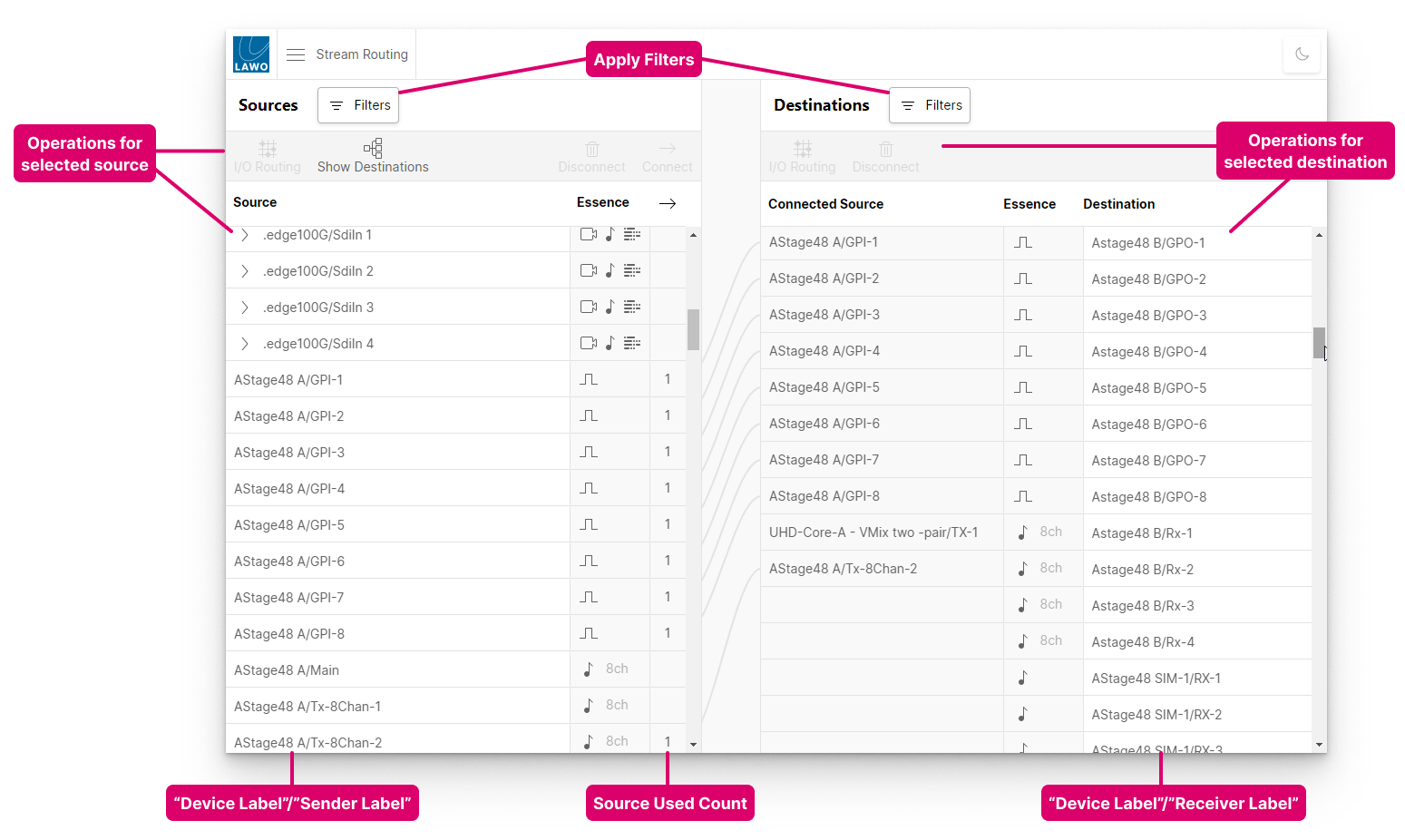HOME - The Stream Routing Page
The "Stream Routing" page manages the streaming connections. From here you can connect a sender to a receiver, or interrogate the existing connections. The operation is identical to the I/O Routing page except that the connections are made at a stream level as opposed to a channel level.

The page lists all available senders (on the left) and receivers (on the right). In each case, you will see two labels, one for the device and one for the sender or receiver. Use the vertical scroll bars to scroll up and down each list.
- If a destination is connected, then the source stream label appears in the "Connected Source" column. If the source is also in view, then a solid line appears.
- If a source is connected, then a number appears in the "source used" column. This indicates the number of connections made. i.e. the number of times a source is used.
- The Essence column describes the type of content: Video, Audio, Metadata or GPIO. If more than one type of content is supported, then an arrow appears beside the source or destination label. Click on the arrow to reveal the individual components.
Applying a Filter
To restrict the view, you can apply one or more filters. For example, to view all of the streaming connections from a particular device type.

You should now see all of the A__stage48 senders (on the left). This view is ideal for connecting the device streams to other receivers on the network.
Making (and Unmaking) Connections
The Connect and Disconnect buttons are used to make and unmake the streaming connections.
Connecting a Sender to a Receiver
To make a connection, select a source and a destination.

Then click Connect - the dotted (preview) line changes to a solid line and the "Connected Source" field updates.

Using Disconnect
To remove a connection, select either a source or destination and click Disconnect.
- If you disconnect a source, then all of its connections are removed and the "source used" field clears.
- If you disconnect a destination, then only the one connection is removed and the "Connected Source" field clears.
Connecting Multiple Senders to Multiple Receivers
You can select multiple sources and destinations by pressing and holding the SHIFT or CTRL buttons on your keyboard. This makes it easy to connect or disconnect multiple streams in one operation.
Follow the same steps as before, but press and hold SHIFT to select a range. Once a range is selected, press and hold SHIFT to increase (or decrease) the selected range. Alternatively, press and hold CTRL to select (or deselect) individual streams.
When you click Connect (or Disconnect), the assignments are made in one operation. For example, to connect four senders to four receivers.

If there is a mismatch between the number of selected sources and destinations, then the sources are assigned consecutively to the available destinations. The exception is for a single source and multiple destinations: in this instance, the source is connected to all selected destinations (as shown below).

Interrogating the Connections
If a sender is connected, then it can be interrogated as follows.
1. Select a source and click on Show Destinations.
The view updates to show only the destinations of the selected source (or sources).

Tip: You can select a different source, or use SHIFT or CTRL to select multiple sources, while Show Destinations is active.
2. Click on Done to exit the "Show Destinations" view and return to the list of all sources and destinations.
Opening the I/O Routing
For convenience, it is possible to open the I/O Routing page for an audio sender or receiver. This allows you to map the stream's IP channels to the device I/Os, and vice versa.
1. Select a sender (or receiver) and click on I/O Routing.
The "Routing" window opens.
Note that the I/O Routing button is not available if you select more than one sender or receiver.
The operation is identical to that described earlier.